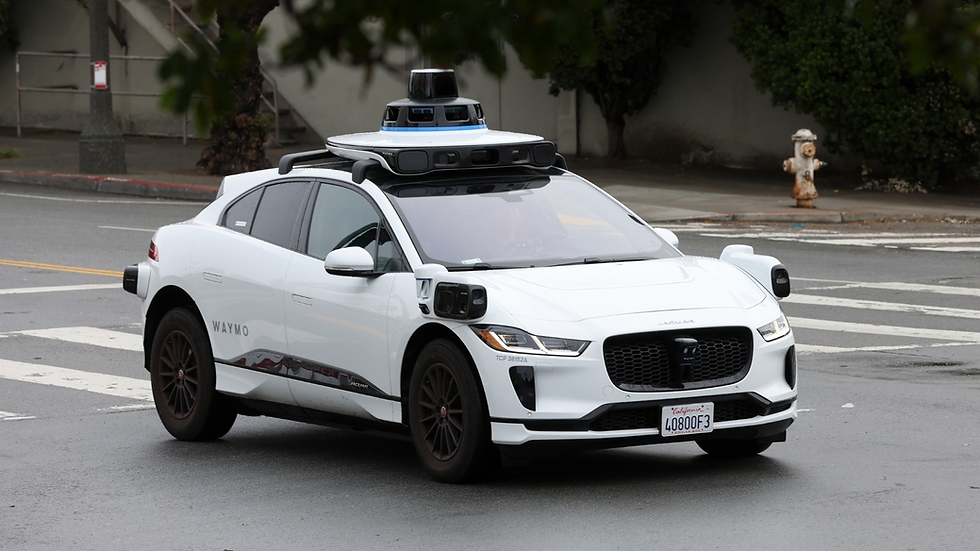Driverless Vehicles: Current Movement and Outlook
- Dr. Mark Lee Levine, Professor

- Nov 21, 2020
- 4 min read
Updated: Nov 23, 2020
Over the last many years, we have written about driverless vehicles (DV) and their coming impact in many areas of our lives, public and private.
A great number of studies have taken place and a good deal of technology has developed in this area of DV, influencing our current and future positions, both on the government level and the private level.
This Tip examines only a sprinkling of the many recent announcements by private companies and governmental bodies as to new laws, testing, and use of many types of DV. These many types include the passenger automobile; but, it also includes DV buses, trucks, farm equipment, delivery machines and much more. Once again, the notes, below, provide a good sampling of recent developments in this arena.
US and International Use of DV:
Those residing in the US tend to assume that the strong progress in DV are coming from the discoveries and advancements in the US. Such position is only partially correct, given many studies that indicate that the US might often be in the top 10 countries leading in this field. However, the countries that seem to be making faster advances on DV issues are apparently many of those in Asia and in the Northern part of Europe. This does not mean the US is not active in this field, as indicated, below. Further, there are, for example, many other international countries that are feverously dedicating huge resources to advancing technology and design issues, among other concerns, in the DV field. Israel, for example, remains an active player in this field.
Technological Issues with DR:
How to be “certain,” from a mechanical/technological standpoint that the DV will operate properly is an area that scientists and others have been struggling with for a number of years. Progress has been made, including development of levels of DV performance. (These are often referred to as the 5 or 6 levels of automation in driving. These levels were developed by various groups. The reference for these levels is generally the Society of Automotive Engineers ( SAE).[1])
Non-tech Issues Involving DR:
Yes, as mentioned, there are clearly many issues of concern with DV and technology. Learning how to avoid major weather issues, hacking and related safety issues, and many other sophisticated tech issues are important and need solutions before DV will be common place on the roads of the world. However, even discounting these concerns, there are also many non-tech developments that have raised the level of concern when dealing with DV. Some of those concerns address the psychology of users or possible users of DV accepting the use of the DV. Matters of safety and fear as to the reliability of the DV are a few of these issues that are being examined by possible users of DV.
Clearly some demographic groups are much more willing to accept the DV innovation than is true with other groups or individuals of a given age, gender, or background. The willingness of potential users of DV to accept the DV auto, bus or other vehicle is no small issue. A major study of these issues was recently completed as to DV passengers or potential passengers in China. This study, entitled: “Public Acceptance of Driverless Buses in China: An Empirical Analysis Based on an Extended UTAUT Model,”[2]recognized the concerns with DV when that technology was employed with buses in China. This same type of concern by potential users of DV remains a major concern that must be properly addressed by all parties involved with DV.
Where Are We Today and How Soon Will DV Be Commonplace?
This question remains as a big issue in the field of DV. While many companies, such as Waymo, Tesla, Uber, Lyft, Argo AI, Nissan, GM, nuTonomy, and many others are pushing hard to be ahead in the DV market, there are many problems, as noted above, to solve, prior to seeing that the DV is ubiquitous in the market place of the world. (Of course, there are already many forms of DVs—cars, buses, trucks, etc.—already employed—now--on many highways throughout the world.)
It appears that most of the major entities working to bring the fully automated DV in to the market, gaining a sizeable piece of the market, are looking to a time frame of “early in the 2020s—or shortly thereafter.”
The artificial intelligence employed in the DV means huge changes and billions and billions of dollars. The race for The DV continues to be one of the most important changes in the “2020s” that will have a massive impact on societies throughout the world.

By
Dr. Mark Lee Levine,
Professor, University of Denver
[1] See, for example, a discussion of these SAE levels in https://www.sae.org/standards/content/j3016_201806/. See also a more in depth analysis of this issue and related points on safety and liability with DV as found in Levine, Mark Lee, Segev, Libbi Levine, and Thode, Stephen F, “A largely Unnoticed Impact on Real Estate—Self-Driven Vehicles,” 85, #1 Appraisal Journal51 (winter, 2017). The distinction of the “5 or 6” levels is that some studies start with level 0 and some start with level 1; both move to level 5, the 5th level being the most automated level, allowing for no required input by a driver and in all road conditions. Thus, the movement is from no automation to fully autonomous driving. [2] Jian Chen, Rui Li, Mi Gan, Zhiyan Fu, Fatao Yuan, "Public Acceptance of Driverless Buses in China: An Empirical Analysis Based on an Extended UTAUT Model", Discrete Dynamics in Nature and Society, vol. 2020, Article ID 4318182, 13 pages, 2020. https://doi.org/10.1155/2020/4318182



Ceramic paint coatings are a great way to add a layer of protection against the elements and scratches. Ceramic Car Paint attn2detail Coatings are also popular because they are easy to clean, which is important if you want your car last long.